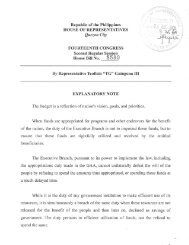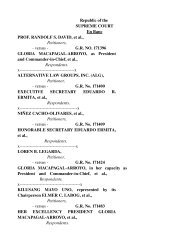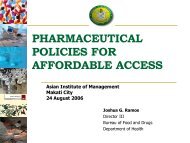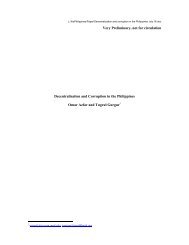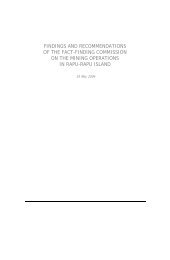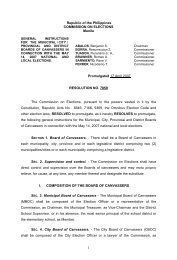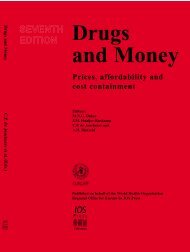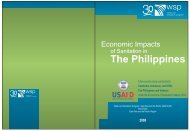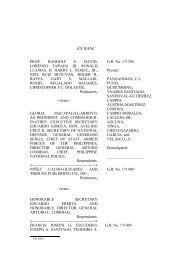FINAL REPORT - Philippine Center for Investigative Journalism
FINAL REPORT - Philippine Center for Investigative Journalism
FINAL REPORT - Philippine Center for Investigative Journalism
Create successful ePaper yourself
Turn your PDF publications into a flip-book with our unique Google optimized e-Paper software.
Abad further mentioned that among the members of the House of<br />
Representatives whose names were used in the fertilizer fund scam<br />
were Representatives Noynoy Aquino of Tarlac and Miguel Zubiri of<br />
Bukidnon. Senator Biazon added to the list Muntinlupa Rep. Ruffy<br />
Biazon as not among the proponents of any project under the<br />
fertilizer fund.<br />
The Rape of the Nation:<br />
Ten Reasons Why The Fertilizer Issue is a Scam<br />
The fertilizer fund as covered by the Farm Inputs and Implements<br />
program is a premeditated, systematic and grand agricultural theft.<br />
In the words of farmers and taxpayers, the fertilizer fund scam is the<br />
rape of the nation. In all indications, it was purely adopted to suit<br />
electoral purpose.<br />
The mismanagement of the fertilizer fund is novel in its method and<br />
astounding in its shamelessness. In fact, it is an object lesson in the<br />
abuse of power and the misuse of people's money by some officials of the<br />
Department of Agriculture and some local leaders.<br />
Ten reasons are advanced why this fertilizer fund mismanagement is<br />
considered the grand agricultural theft (grand theft agro):<br />
First, as confirmed by Secretary Panganiban himself during the budget<br />
hearing, nobody in the Department of Agriculture knew of the existence<br />
of the Farm Inputs and Implements program. In the files of the<br />
Department itself, there is no single document that would support<br />
the existence of such program.<br />
Second, while agricultural and fisheries modernization has been a staple<br />
of the agriculture budget every year since the AFMA enactment in 1997,<br />
the fertilizer fund was a single appropriation meant only <strong>for</strong> 2004.<br />
This huge expense has not been repeated since. Why it was<br />
implemented only in 2004, in the months of the election season in<br />
particular, is an indication of its intended purpose and illicit<br />
objective.<br />
Third, even the design and implementation of the fertilizer fund scam<br />
manifest the height of scandalous corruption. The gross overpricing as<br />
reported by the Commission on Audit is absolutely abominable, with<br />
the ordinary foliar fertilizer (which was allegedly supplied in almost all<br />
transactions) overpriced from almost 700 to 1,250 percent.<br />
The Commission on Audit through an Audit Observation<br />
Memorandum dated January 20, 2006 submitted its report to the<br />
committees. Its observations are all indicative of massive<br />
irregularities including overpricing, frontal violations of the<br />
158



